|
|
 |
|
Harpacticoida ( Order ) |
|
|
|
Clytemnestridae ( Family ) |
|
|
|
Clytemnestra ( Genus ) |
|
|
| |
Clytemnestra asetosa Huys & Conroy-Dalton, 2000 (F,M) | |
| | | | | | | Syn.: | Clytemnestra scutellata : Gurney, 1927; Boxshall, 1979 | | | | Ref.: | | | Huys & Conroy-Dalton, 2000 (p.24, 45, Descr.F, figs.F, Rem.); Huys & Boxshall, 2004 (p.278) | 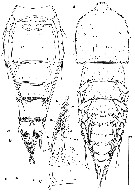 issued from : Huys and Conroy-Dalton in Bull. nat. Mus. Lond., 2000, 66 (1). [p.25, Fig.15]. Female (from Port Taufiq, Bay of Suez): A, habitus (dorsal); B, urosome (ventral); C, anal somite and right caudal ramus (dorsal). Scale bars in micrometers. Nota: backwardly produced alate processes of somites bearing P2-P4 distinctly shorter than in C. scutellata and C. gracilis
|
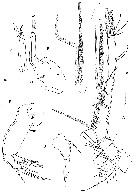 issued from : Huys and Conroy-Dalton in Bull. nat. Mus. Lond., 2000, 66 (1). [p.26, Fig.16]. Female: A, A1 (ventral; inset showing acrothek at full length); B, Md (posterior); C, Md (mandibular gnathobase (secondary tooth arrowed); D, Mx1; E, Mx2 (posterior; small arrow: exit of maxillary gland; large arrow indicating position of proximal endite in other Clytemnestra species). Scale bars in micrometers.
|
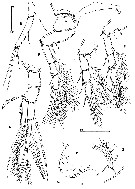 issued from : Huys and Conroy-Dalton in Bull. nat. Mus. Lond., 2000, 66 (1). [p.27, Fig.17]. Female: A, P1 (anterior); B, P2, intercoxal sclerite, protopod and exopod (anterior); C, P3, distal portion of basis and exopod (anterior); D, P4, distal portion of basis and exopod (anterior); E, P5 (anterior); F, rostrum (dorsal); G, exopod of A2. Scale bars in micrometers. Nota: P1 as in C. scutellata but setules along margin of endopodal segment 1 absent. P2-P4 with only 2 outer spines on exopodal segment 3.
|
 issued from : Huys and Conroy-Dalton in Bull. nat. Mus. Lond., 2000, 66 (1). [p.24, Fig.19]. Female: Armature formula P2-P4. Nota: P1 as in C. scutellata but setules along inner margin of endopodite segment 1 absent. P2-P4 with only 2 outer spines on exopodite segment 3
|
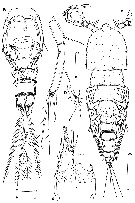 issued from : Huys and Conroy-Dalton in Bull. nat. Mus. Lond., 2000, 66 (1). [p.25, Fig.15]. Female: A, habitus (dorsal); B, urosome (ventral); C, anal somite and right caudal ramus (dorsal). Scale bars in micrometers.
|
 issued from : Huys and Conroy-Dalton in Bull. nat. Mus. Lond., 2000, 66 (1). [p.28, Fig.18]. Male: A, habitus (dorsal); B, urosome (ventral); C, P5 (anterior); D, P6; E, anal somite and right caudal ramus (dorsal). Scale bars in micrometers. Nota: Body with similar projections as in female; urosome more slender with genital and 1st abdominal somites separate. Caudal rami with setae I-II; setae IV-V very long (75 % of urosome length) and plumose; seta VI much longer than in female.
|
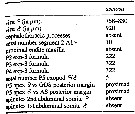 issued from : Huys and Conroy-Dalton in Bull. nat. Mus. Lond., 2000, 66 (1). [p.45, Table 1]. Diagnostic characters. A1 = antennule; GDS = genital double-somite; AS = first abdominal somite. Measurements based on material examined in the publication.
| | | | | NZ: | 1 | | |
|
Distribution map of Clytemnestra asetosa by geographical zones
|
| | | | Loc: | | | Red Sea, Bay of Suez, Suez Canal.
Type locality: Bay of Suez (Port Taufiq). | | | | N: | 2 | | | | Lg.: | | | (931) F: 0,758-0,830; {F: 0,76-0,83} | | | | Rem.: | For Huys & Conroy-Dalton (2000, p.29) the early copepodid stages from the central Red Sea were identified on the basis of the absence of the proximal endite of Mx2 and the shape of the cephalothorax.C. asetosa, originally identified as C. scutellata by Gurney (1927), is the smallest species in the genus. It is similar to C. farrani in many species but differs from it in the armature of A1, the loss of the proximal endite of Mx2, the presence of only 2 outer spines on P3-P4 exopodal segment 3 and a different spinulation pattern on the female urosome.
Identification characters after G.A. Boxshall & S.H. Halsey (2004, p.278):
1- Exopod of P1 with 4 distal setal elements; female A1 7-segmented.
2- Exopod of P5 in both sexes armed with 5 setae; 3rd exopodal segment of P2 with total of 6 spines/setae.
3- 3rd exopodal segment of P3 and P4 each with total of 7 spines/setae.
4- Male P5 less elongate than in C. longipes, with apex of exopodal segment not reaching as far as posterior margin of 1st free abdominal somite; Mx2 lacking proximal endite. | | | Last update : 13/09/2015 | |
|
|
 Any use of this site for a publication will be mentioned with the following reference : Any use of this site for a publication will be mentioned with the following reference :
Razouls C., Desreumaux N., Kouwenberg J. and de Bovée F., 2005-2025. - Biodiversity of Marine Planktonic Copepods (morphology, geographical distribution and biological data). Sorbonne University, CNRS. Available at http://copepodes.obs-banyuls.fr/en [Accessed June 04, 2025] © copyright 2005-2025 Sorbonne University, CNRS
|
|
 |
 |








